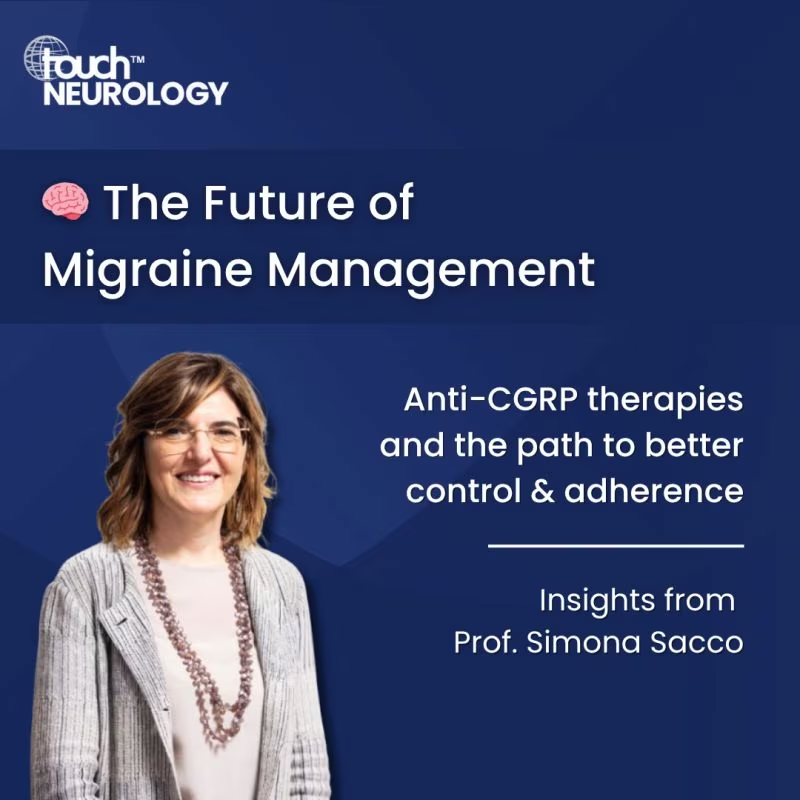Prof. Simona Sacco is a leading neurologist based at the University of L’Aquila, Italy, and currently serves as the President of the European Stroke Organisation (ESO). Her research spans migraine pathophysiology, stroke management, and health equity across Europe. In this expert interview, conducted at the 2025 European Academy of Neurology (EAN) Congress, Prof. Sacco discusses the evolving science behind anti-calcitonin gene-related peptide (CGRP) therapies for migraine and the promise of new delivery methods.
1. What is the mechanism of action of anti-CGRP monoclonal antibodies and gepants in migraine prevention, and what advantages do they offer over non-specific therapies?
Anti-CGRP therapies work predominantly at the peripheral level, where the trigeminovascular system plays a crucial role in migraine pathology. Both monoclonal antibodies and gepants inhibit CGRP transmission either by binding directly to the ligand or to the CGRP receptor.
While these agents don’t cross the blood–brain barrier in significant amounts, some studies using neuroimaging and neurophysiology have shown central nervous system changes. So we know that there’s also a central effect, and that they may be indirect or related to pain relief rather than a direct pharmacological action.
In terms of advantages, these drugs offer substantial improvements in both efficacy and tolerability. Although few head-to-head trials exist, indirect comparisons and network meta-analyses suggest they outperform traditional therapies. In clinical practice, they help more patients reach meaningful outcomes, including complete migraine freedom, which, in the past has not seemed achievable.
Other advantages include tolerability. The new drugs that inhibit CGRP pathway have minor and infrequent side effects, with rare discontinuation due to side effects. As a result, treatment adherence is very high, which is vital given the chronic nature of migraine. This marks a major step forward compared with previous treatment options that often led to discontinuation due to this major challenge.
2. What real-world evidence and challenges have emerged regarding efficacy and tolerability of anti-CGRP therapies?

We now have strong real-world data supporting the results observed in clinical trials. These studies include large patient populations and show high effectiveness, with up to 60% of patients responding to treatment, and no significant adverse events.
One emerging adverse event identified in real-world use is the potential for Raynaud’s phenomenon in patients with pre-existing peripheral vasoconstriction. This was not known from clinical trials but emerged in clinical practice. And, in some cases, can lead to discontinuation, but luckily, it’s only been found in a minority of patients. If a patient has already mild signs on peripheral vasoconstriction, the Raynaud phenomenon can appear if they start using anti-seizure medications. Although rare, this may require careful patient selection and monitoring.
3. How do emerging delivery methods, such as intravenous anti-CGRP infusions, impact treatment expectations and adherence in migraine care?
CGRP-targeting therapies are now available in three main delivery forms: subcutaneous injections (monthly or quarterly), daily or every other day oral tablets (gepants), and quarterly intravenous infusions. Each route has advantages and disadvantages.
Oral drugs require daily compliance, which may not suit every patient, though their short half-life can be an advantage, especially for patients planning pregnancy.
Intravenous administration, conducted in a hospital setting, can be ideal for patients who need closer supervision or where compliance is uncertain. It gives clinicians more control and reassurance that the drug is administered properly. This approach may suit certain migraine patients very well.
Presented workshop at EAN 2025: Understanding the mechanisms: Anti-CGRP pathway therapies in migraine treatment part of the focused workshop: Advancements in migraine treatment: Exploring anti-CGRP and anti-PACAP pathway therapies
Interviewer: Caroline Markham, Head of Partnerships.
Editor: Katey Gabrysch, Editorial Director.
Disclosures: Simona Sacco has nothing to disclose in relation to this interview. No funding was received in the publication of this article.
This content has been developed independently by Touch Medical Media for touchNEUROLOGY. Views expressed are the speaker’s own and do not necessarily reflect the views of Touch Medical Media.
Cite: Anti-CGRP therapies improve migraine control and adherence: Simona Sacco, EAN 2025. touchNEUROLOGY. 23 June 2025.
Register now to receive the touchNEUROLOGY newsletter!
Don’t miss out on hearing about our latest peer reviewed articles, expert opinions, conference news, podcasts and more.












